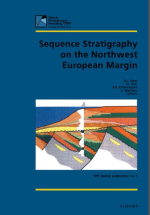Добрый день, Коллеги. Важное сообщение, просьба принять участие. Музей Ферсмана ищет помощь для реставрационных работ в помещении. Подробности по ссылке
Sequence stratigraphy on the Northwest European margin / Секвенс-стратиграфия северо-западной Европы
Significant problems are being encountered by stratigraphers as they attempt to apply Exxonian sequence analysis to the depositional record. The most serious problem is one of consistent and objective boundary recognition. The unconformable portion of the boundary usually can be recognized with reasonable objectivity but a major problem occurs when the boundary is a "correlative conformity". The Exxon model defines such a surface as the depositional surface which existed at the time of the end of base level (relative sea level) fall. In many cases this theoretical surface has no apparent lithologic expression and cannot be recognized objectively. Thus correlation of a depositional sequence throughout a basin is either impossible or is an extremely subjective exercise.To remedy the problem of boundary recognition it is proposed that a sequence boundary be placed at the subaerial unconformity and at the correlative transgressive surface. The transgressive surface is ideal for the conformable portion of a sequence boundary because: (1) it is very distinctive lithologically and occurs in both ramp and shelf/slope settings; (2) it has only minor diachroneity in most cases; (3) it merges with the basinward termination of the unconformable portion of the sequence boundary. This methodology results in a practical, genetic unit (T-R sequence) which can be objectively correlated.
A second problem with current sequence stratigraphic practice is the use of a sequence hierarchy scheme which is based on frequency of boundary occurrence. This system is very subjective in nature and is prone to circular reasoning. To counter the hierarchy problem, a hierarchical arrangement of T-R sequence boundaries has been established using boundary characteristics which include: (1) extent of the boundary, (2) extent of the unconformable portion of the boundary, (3) degree of deformation of strata directly underlying the boundary, (4) magnitude of deepening across the boundary, (5) degree of change of the depositional regime across the boundary, and (6) degree of change of the tectonic regime across the boundary. These characteristics reflect the magnitude of base level changes which generate sequence boundaries and this linkage allows the establishment of a hierarchy. Five distinct orders of sequence boundaries are recognized in the hierarchy and vary from 1st order boundaries which are widespread subaerial unconformities associated with significant deformation, to 5th order boundaries which are transgressive surfaces which can be correlated only locally. <...>




